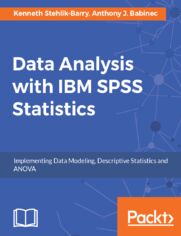Data Analysis with IBM SPSS Statistics - Helion

Tytuł oryginału: Data Analysis with IBM SPSS Statistics
ISBN: 9781787280700
stron: 435, Format: ebook
Data wydania: 2017-09-22
Ksi─Ögarnia: Helion
Cena ksi─ů┼╝ki: 39,90 z┼é (poprzednio: 181,36 z┼é)
Oszczędzasz: 78% (-141,46 zł)
Master data management & analysis techniques with IBM SPSS Statistics 24
About This Book
- Leverage the power of IBM SPSS Statistics to perform efficient statistical analysis of your data
- Choose the right statistical technique to analyze different types of data and build efficient models from your data with ease
- Overcome any hurdle that you might come across while learning the different SPSS Statistics concepts with clear instructions, tips and tricks
Who This Book Is For
This book is designed for analysts and researchers who need to work with data to discover meaningful patterns but do not have the time (or inclination) to become programmers. We assume a foundational understanding of statistics such as one would learn in a basic course or two on statistical techniques and methods.
What You Will Learn
- Install and set up SPSS to create a working environment for analytics
- Techniques for exploring data visually and statistically, assessing data quality and addressing issues related to missing data
- How to import different kinds of data and work with it
- Organize data for analytical purposes (create new data elements, sampling, weighting, subsetting, and restructure your data)
- Discover basic relationships among data elements (bivariate data patterns, differences in means, correlations)
- Explore multivariate relationships
- Leverage the offerings to draw accurate insights from your research, and benefit your decision-making
In Detail
SPSS Statistics is a software package used for logical batched and non-batched statistical analysis. Analytical tools such as SPSS can readily provide even a novice user with an overwhelming amount of information and a broad range of options for analyzing patterns in the data.
The journey starts with installing and configuring SPSS Statistics for first use and exploring the data to understand its potential (as well as its limitations). Use the right statistical analysis technique such as regression, classification and more, and analyze your data in the best possible manner. Work with graphs and charts to visualize your findings. With this information in hand, the discovery of patterns within the data can be undertaken. Finally, the high level objective of developing predictive models that can be applied to other situations will be addressed.
By the end of this book, you will have a firm understanding of the various statistical analysis techniques offered by SPSS Statistics, and be able to master its use for data analysis with ease.
Style and approach
Provides a practical orientation to understanding a set of data and examining the key relationships among the data elements. Shows useful visualizations to enhance understanding and interpretation. Outlines a roadmap that focuses the process so decision regarding how to proceed can be made easily.
Osoby które kupowały "Data Analysis with IBM SPSS Statistics", wybierały także:
- Fundamentals of Metadata Management. Uncover the Meta Grid and Unlock IT, Data, Information, and Knowledge Management 249,17 zł, (29,90 zł -88%)
- Semantic Modeling for Data 249,17 zł, (29,90 zł -88%)
- Power BI Desktop. Kurs video. Wykorzystanie narzędzia w analizie i wizualizacji danych 332,50 zł, (39,90 zł -88%)
- The Practitioner's Guide to Graph Data. Applying Graph Thinking and Graph Technologies to Solve Complex Problems 230,00 zł, (29,90 zł -87%)
- R Cookbook. Proven Recipes for Data Analysis, Statistics, and Graphics. 2nd Edition 230,00 zł, (29,90 zł -87%)
Spis tre┼Ťci
Data Analysis with IBM SPSS Statistics. Implementing data modeling, descriptive statistics and ANOVA eBook -- spis tre┼Ťci
- 1. Installing and Configuring SPSS
- 2. Accessing and Organizing Data
- 3. Statistics for Individual Data Elements
- 4. Dealing with Missing Data and Outliers
- 5. Visually Exploring the Data
- 6. Sampling, Subsetting and Weighting
- 7. Creating New Data Elements
- 8. Adding and Matching Files
- 9. Aggregating and Restructuring Data
- 10. Crosstabulations Patterns for Categorical Data
- 11. Comparing Means and ANOVA
- 12. Correlations
- 13. Linear Regression
- 14. Principal Components and Factor Analysis
- 15. Clustering
- 16. Discriminant Analysis





